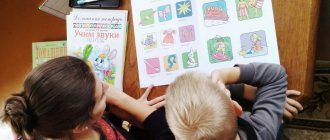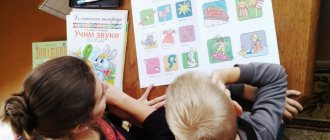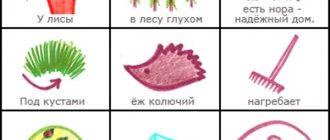Description of the test Pictogram according to the A.R. method Luria
Alexander Romanovich Luria is a follower of Lev Semenovich Vygotsky, one of the founders of Russian neuropsychology. The Pictogram test, developed by him as part of the development of this area of science, allows us to identify the features of memorization through associative connections. The objectives of the study are:
- identifying the nuances of indirect memorization;
- assessment of memory productivity;
- determining the nature of mental activity;
- studying the level of development of imaginative thinking.
The technique is not used for diagnosing preschoolers and primary schoolchildren, but is only suitable for testing among subjects with at least 67 years of education.
Application of the methodology for testing schoolchildren
The stimulus material for the test is a set of 1520 words or phrases of concrete (hungry child) or abstract content (doubt):
- fun party;
- hard work;
- development;
- delicious dinner;
- a brave deed;
- disease;
- happiness;
- parting;
- poisonous question;
- friendship;
- dark night;
- sadness;
- justice;
- doubt;
- warm wind;
- deception;
- wealth;
- hungry child.
Moreover, the technique does not involve the use of a standardized list of words; the experimenter can create his own set or replace only a few proposed options. Thus, the test can be carried out as many times as required by working with a particular subject.
Diagnostics are organized both in group form and individually. To conduct the study, the subject will need to be given a piece of paper and a pen or pencil.
Instructions for schoolchildren 1216 years old:
- The experimenter announces the conditions of the study: We will examine your visual memory. I will begin to name the words, and your task is to draw a picture, which will then help you remember what you heard. You cannot write down or depict individual letters.
- Then the adult clearly and loudly names the words, first specifying the serial number of each expression. The interval between utterances should not be more than 1 minute.
- While drawing, you can ask your child leading questions (What are you drawing? or How will this help you remember the word?).
- 4060 minutes after the end of the test, during which the experimenter allows the students to do other things, the subjects are provided with forms with their answers.
- After this, the adult invites the children to independently reproduce all the words they heard, looking at the pictures shown (in the group form of the test, students will need to sign their pictograms, and in the individual test, it is recommended that the child name the concepts out of order).
For older subjects, words should be read at intervals of only 30 seconds.
During the work, the experimenter must draw the students’ attention to the fact that the test results do not depend on the level of their visual abilities.
Using pictograms in working with preschoolers
The use of pictograms in speech development and the development of thought processes in working with preschool children
1. Literary review of the state of the issue. 1.1. History of the topic of teaching experience in pedagogy. Preschool education is the first stage in the education system, therefore the main task of a teacher working with preschoolers is to develop interest in the learning process and its motivation, development and correction of speech. Children of older preschool age with various speech disorders experience significant difficulties in memorizing poems and short stories and reproducing them. When working with children with special needs, the teacher has to look for auxiliary means that facilitate, systematize and guide the process of children learning new material. One such tool is a pictogram. What is a pictogram? A pictogram (from Latin - to draw and Greek - to write) is a sign that displays the most important recognizable features of an object, objects, phenomena to which it indicates, most often in a schematic form. The history of the use of pictograms dates back almost to primitive times. It is known that people first learned to draw, and then write in letters. Many such drawings were found on the walls of caves where ancient people lived. It turned out that the ancient people left letters and stories for their descendants, although they did not know how to write. A pictogram is one of the types of prewriting, which is a pictorial letter, or painting - an image of objects, events and actions using conventional signs. Writing significantly changed the handling of information, but during this period interest in memory management methods was very high. Among the most prominent scientists who worked on the issue of memorization was Giordano Bruno (XV1st century). Giordano's modern memory system is named after him. In the twentieth century, the “Pictogram” technique was developed and used in psychological research. In the 60s and 70s, the use of this technique expanded. In Russia, the targeted use of mnemonics is still a young direction in the field of pedagogy. Communication problems in cases of severe speech dysfunction are solved using certain communication strategies that increase the ability to understand and facilitate information exchange between people. Blissymbolics is a writing system developed by Charles Bliss in 1965. It is understandable to people speaking any language. The symbol set consists of approximately one hundred pictorial ideographemes and randomly generated symbols that can be used either individually or in certain combinations. In the world of special education, the Makaton symbol system is very common, the history of which began in 1972 with a dictionary of symbols. Makaton consists of two interconnected parts that serve as a compensating means of speech. The use of pictograms in preschool pedagogy is called differently. So Vorobyova V.K. – sensory graphic diagrams, Tkachenko TA – subject-specific schematic models, Bolsheva T.V. – collage, Efimenkova L.N. - an outline for composing a story. Thus, having studied the psychological and pedagogical literature, selecting data from scientists on the use of mnemonics in the development of children's memory and speech-thinking activity, I began to question the need to use pictograms and develop non-traditional technologies in the preschool education system for children of senior preschool age. The purpose of introducing intellectual education into the traditional process of an educational institution is to develop memory, imagination, thinking, improve the quality of speech and thinking activity, and comprehensive development of the individual. 1.2. History of studying the topic of teaching experience in an educational institution and municipality. Working as a teacher in a speech therapy group with children with special needs development disorder, I was faced with a problem, namely: - children’s poor memorization of poems and short texts - lack of ability to clearly, consistently express their thoughts, draw conclusions - the presence of speech disorders sharply limited children’s communication with others. When diagnosing speech activity and mental functions, I drew attention to the presence of: - delays in the development of mental operations, causing difficulties in mastering analysis and synthesis, comparison and generalization - impaired attention, leading to difficulties in completing tasks based on verbal instructions. At the same time, children enjoy looking at books based on comics and plot pictures, trying to “read” the text, and after a while retell what was “read”. I came to the conclusion that the ability to remember depends primarily not on memory, but on thinking and attention. Disturbances in the functioning of these mental processes make voluntary memorization almost impossible - the brain does not store information in the usual sense of the word, but is capable of maintaining only internal connections between objects. 1.3. Basic concepts and terms in the description of teaching experience. A pictogram (from the Latin pictus - drawn and Greek gramma - record) is a picture letter used in psychology to study indirect memorization, that is, memorization using means. A pictogram is a set of graphic images that a person comes up with himself for the purpose of memorizing and subsequently reproducing any words and expressions. The verbal type of communication (from the Latin “oral”, “verbal”) is speech, carried out using words, which includes human speech. Voluntary memory is a process of memorization that is carried out in the form of conscious activity. One of the most important techniques is drawing up a plan for the memorized material. Visual-figurative thinking is thinking that is based on modeling and solving a problem situation in terms of ideas. In its simplest form, visual-figurative thinking occurs in preschoolers, i.e. at the age of 4-7 years. Speech-mental activity is a mental activity carried out using information in a form perceived as speech, represented using the alphabet of the corresponding language. Short-term memory is one of the types of memory characterized by a limited storage time of information and a limited number of retained elements. Visualization (from the Latin visualis - visually perceived, visual). The process of visualization is the collapsing of mental content into a visual image; Once perceived, the image can be deployed and serve as a support for adequate mental and practical actions. Mnemonics is a system of various techniques that facilitate memorization and increase memory capacity by forming artificial associations. Association is a natural connection between two contents of consciousness (sensations, ideas, thoughts, feelings, etc.), which is expressed in the fact that the appearance in consciousness of one of the contents entails the appearance of the other. Memorization is a memory process through which information is entered into memory. 2. Psychological and pedagogical portrait of a group of students who are the basis for the formation of the presented pedagogical experience. The correctional group is speech therapy. The age of the children is from 5 to 7 years. The number of pupils is 12 people. Pupils in this group are diagnosed with general speech underdevelopment. It's no secret that children with ODD have the following problems: poor vocabulary, impaired sound pronunciation. Most children have impaired attention, imperfect logical thinking, and short-term memory predominates. At this age, memorization is mainly involuntary: children remember well phenomena, facts, objects that are close to life experience. Studies have shown that the volume of visual memory and the ability to memorize semantics in children with ODD are practically no different from the norm, while auditory memory and memorization productivity are noticeably reduced. There are many problems in the speech of children: - insufficient vocabulary and, as a consequence, poverty of speech; - monosyllabic speech, inability to construct common sentences; - use of filler words and non-literary words and expressions; - lack of speech culture skills: intonation expressiveness, regulation of speech tempo and voice strength. Our task is to teach children to express their thoughts coherently, consistently, and grammatically correctly. The subject-development environment in the group is created in accordance with the requirements of FGT and the Program that is implemented in the preschool educational institution: - speech material is regularly updated in accordance with the lexical topic being studied; — games, toys and aids are systematically changed throughout the year; — comfortable, safe conditions for children to practice and play are created; — space is created for the emotional well-being of children in the group. Interaction with the family: - regular parent meetings, trainings, consultations, project activities - design of parent corners, moving folders, stands, recommendations, information sheets on the development and upbringing of children; — helping parents understand the need to participate in the development of children — leading parents to understand the child’s educational program; - involving parents in active participation in the child’s education. 3.Pedagogical experience. “If you teach a child some five words unknown to him, he will suffer for a long time and in vain, but connect twenty such words with pictures, and he will learn them on the fly.” K.D. Ushinsky. 3.1.Description of the main techniques and methods used in the presented teaching experience. A pictogram is a system of various techniques that facilitate memorization and increase memory capacity by forming additional associations, organizing the educational process in the form of a game. The use of pictograms is now becoming relevant. A pictogram refers to non-verbal means of communication: when a child connects several visual images in his imagination, the brain records this relationship, and when recalling one of the images of this association, the brain reproduces all previously connected images. Pictograms are a set of rules and techniques that facilitate the memorization process. In children with ODD, it is especially important to develop visual-figurative thinking, using symbols and diagrams, which underlie the formation of artificial associations that facilitate the memorization process and increase memory capacity. Reliance on a visual image is very important, since when reproducing a text, a visual image appears in the imagination and this is the shortest path to forming the process of memorization and accurate transmission of information, for example, in poetry and texts. For this, a schematic representation of the individual parts is sufficient, which facilitates memorization and subsequent reproduction of the entire image in rhymed form. The essence of using pictograms is that for each word or small phrase an image is created, thus the entire poem is sketched. After this, the child reproduces the entire poem from memory, using a graphic image. Mastering the techniques of working with pictograms greatly facilitates and reduces the time of learning and mastering the material, and develops techniques for working with memory. After all, one of the rules for strengthening memory says: “When you learn, write down, draw diagrams, draw graphs.” 3.2. Relevance of teaching experience. A child’s thinking develops through a visual and accessible form. Consequently, I see the relevance of using pictograms in working with children with special needs in the following: - pictograms make it easier for children with special needs to master coherent speech, because facilitate memorization and increase memory capacity and generally develop children’s speech and thinking activity; — pictograms use natural memory mechanisms and allow you to fully control the process of memorizing, storing and recalling information; - children who have mastered the use of pictograms are subsequently able to independently develop speech in the process of communication and learning. When implementing this technology, I set myself the following tasks: - to help children organize and systematize cognitive information about the environment; — enrichment of children’s vocabulary and development of coherent speech; — teaching consistency, logic and coherence of presentation; — nurturing the need for verbal communication; - development of thinking, imagination, speech-auditory and visual memory; - development of fine motor skills. 3.3. Scientificity in the presented pedagogical experience. Many preschool teaching methods are based on the use of pictograms, for example, the method of teaching preschool literacy developed by D.B. Elkonin and L.E. Zhurova. Schemes and models gradually accustom children to observing language. Schematization and modeling helps the child see the connection between words in a sentence and text. This develops interest in words, communication, and improves children’s speech and thinking activity. Mastering the techniques of using pictograms significantly reduces learning time and at the same time solves the following problems: - development of basic mental processes of memory, attention, imaginative thinking; — information recoding – transformation of abstract symbols into images; — development of fine motor skills during graphic reproduction. To stimulate imagination and creative speech actions at the initial stage of work, it is necessary to form sign-symbolic functions in children. They bear symbols of a different nature: - geometric figures; — symbolic images of objects: silhouettes, contours, symbols. Pictograms are especially effective when learning poems, finger games, and retelling fairy tales. The bottom line is that for each word or phrase a picture is drawn up and the work is sketched out schematically. After this, the child, using the support of a graphic image, reproduces the text in its entirety. 3.4. The effectiveness of teaching experience. Scientific research has proven that the volume of visual perception of the surrounding world in children is 75%. Based on this, the use of pictograms in working with children allowed me to increase the level of development of coherent speech in children. At the same time, solve problems for the development of basic mental processes and, as a result, sufficiently prepare children for school. Having chosen the topic of the pedagogical experience “Use of pictograms”, the following results were expected at the final stage: - replenishment and activation of children’s vocabulary; — improvement of coherent speech; — development of logical and figurative thinking, memory development; — formation of the integrity of the surrounding world; — ability to search for information and materials for research activities; - ability to process collected material. The results of my activities can be judged by the monitoring carried out. So, when memorizing a poem verbally, the results were as follows: 20% low level of memorization, 50% average level, 30% high. Memorizing poems using pictograms (non-verbal method) gave the result - 0% low level, 40% average level, 60% high level. Comparative diagnostics of the development of coherent speech in children of the speech therapy group in the period from September 2011 to May 2013. The final diagnostics showed that the level of speech development has improved significantly and positive dynamics are visible. 3.5. Novelty of teaching experience. When using schemes, the nature of children’s activities changes: they get the opportunity not only to hear their own speech or that addressed to them, but also to see its elements. The child masters the operations of analysis and synthesis using visually presented material. A set of pictograms allows you to show the variety of cognates that can be obtained from the original root word. Working with pictograms helps develop a child’s sense of the systemic structure of language, and in the minds of children, words will begin to exist not on their own, but in groups united by one feature. The method of using pictograms can be successfully applied in any educational activity: - development of cultural and hygienic skills - formation of a healthy lifestyle (physical exercises, corrective gymnastics, etc.). - retelling works - memorizing poems - didactic games. 3.6. The technological effectiveness of the presented pedagogical experience. Work on implementing the tasks of using pictograms is carried out in several stages: I. Establishing emotional contact. The basis is emotional contact, which will gradually develop into cooperation. II. Increasing the child's mental activity. III. Creating productive pedagogical communication. Modeling, organization and management of direct training, analysis of results. IV. Creating a single answer - solutions to the problems posed. The teacher must determine the sequence of his actions and the work of the children; the time that will be spent on this type of training; forecasting and performance. The plan for using icons in working with the text: 1. First of all, in the text you need to highlight keywords or short expressions. 2. Then, to each of the selected words or expressions, draw pictures that can subsequently remind this particular word (this picture can be called a visual association for a word), the picture should not be not too schematic, not too detailed. It should be quite simple and does not require special artistic skills. The icon cannot be correct or wrong, the main thing is that it subsequently can recall the word or expression to which it was drawn. 3. Further, depending on the time for memorization, as well as the ability to visualize, different options for working with the text are possible: - First try, looking at the drawings, reproduce the text, as more detail as possible. Then, try to reproduce the text, remembering your pictures mentally, i.e. Without looking at them; - If you need to remember the text for a long time, it is advisable to return from time to time to your icons and try to reproduce it on them. Such a repetition is much more rational than ordinary memorization, the use of icon techniques, is very effective. 3.7. Description of the main elements of the presented pedagogical experience. In the process of traditional learning, I introduced classes using icons once a month with my group, 2 times a month in subgroups and individually. Types of such classes: -traditional-objective-shaped-according to fairy tales, according to literary works, in interests, for free creativity. Techniques for teaching artistic works: - coding in images - memorization (combination of two images) - retelling of information based on the icon - reproduction of the icon. I am guided by them according to this methodology: children listen to the material and, based on figurative and associative thinking, sketch the work constructedly, tying every word to the visual image. I also use other options for using icons. Children are heard pictures with the image of objects, actions, signs. The initial concept of “sign” is a generalized concept - consolidating the skill of independent actions with icons - independent orientation in the system of signs. The standardization of the load is more based on the individual characteristics of children; I carry out a differentiated approach. So I increase the conditions for children to fulfill the assignment gradually. If the child performs the task quickly, then he is given additional tasks (more complicated). With weaker children, we carry out the task at the same time, thereby activating the imagination and speech activity. I pay much attention to the assessment of the activities of children, taking into account the differentiated approach aimed at developing success. In the process of classes, I encourage activity, the ability to express my thoughts, independence, initiative. My work with children, on the introduction of non -traditional technologies (use of icons), gave a positive result. 4. Conclusions. The implementation of pedagogical experience is aimed at mastering the use of icons in the development of speech -mushroom activity of children and the development of memory. This experience allows children: - extract information, conduct research, do comparisons, draw up a clear internal plan of mental actions, speech utterance; - to form and express judgments and conclusions more logical and consistent; - To develop non -speech processes: attention, thinking, all types of memory (visual, auditory, motor, using the technique of sketching the text by children) - to maintain children's interest in active speech activity. The use of this technology allows you to develop not only memory, imagination, attention, but also teaches children to reason, prove, defend their point of view, so we can speak. All of the above is the basis of the basis for the use of experience in the education system, both corrective work with preschool children and in working with children of mass groups of kindergarten.
We recommend watching:
Nurturing preparatory group children's interest in school Organization of play activities in a mixed-age group Walks and observations during the summer in kindergarten Organization of play activities in a mixed-age group
Similar articles:
Environmental education in kindergarten
Active consultation for preschool teachers. Sensory education for preschoolers
Consultation for educators “Use of ICT in working with parents”
Learning English at a preschool educational institution
Methods of teaching modeling to young children in kindergarten





